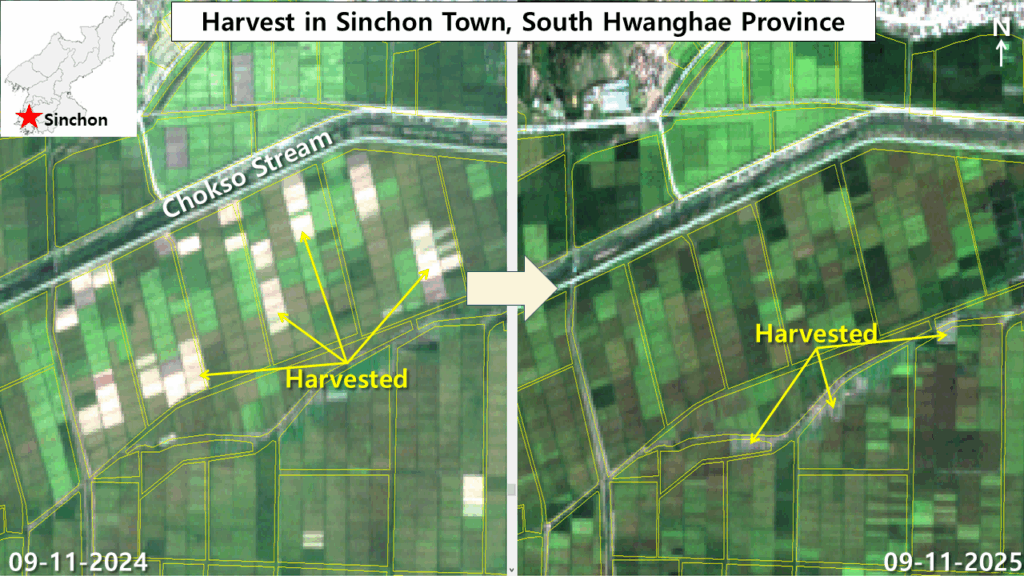It is mid-October, and the fall harvest is well underway in North Korea’s fields of golden grain. The harvest typically begins in late August and continues through early to mid-October, wrapping up by late October at the latest.
I analyzed the current progress of the fall harvest in North Korea using satellite imagery from the Sentinel satellites operated by the European Space Agency. The weather in North Korea this fall has generally been overcast or rainy, making it difficult to find fully usable images on clear days. Fortunately, cloudless images were available on Sept. 11 of both 2024 and 2025, which enabled us to compare and assess the harvest status in those two years.
Our analysis of the Sentinel satellite imagery suggests that this year’s harvest in North Korea’s Hwanghae province is proceeding more slowly than last year. That sluggish progress appears related to a delayed start to rice transplanting this spring due to a shortage of supplies. North Koreans expect, or at least hope, the fall crop will meet last year’s level.
The fall harvest in Sinchon township, South Hwanghae province
The fall harvest is underway at farms in Sinchon township of South Hwanghae province, one of North Korea’s major cereal-producing regions. Images from Sentinel satellites show that North Korean rice paddies are regularly grouped into rectangular plots. These plots are estimated to measure 30 to 50 meters by 100 meters, covering an area of 0.3 to 0.5 hectares.
Satellite images show unharvested rice paddies in colors ranging from light to dark green. After the harvest, the bottom of the paddies becomes visible as white or tan. In the image from Sept. 11 of last year, several clusters of these white-colored harvested paddies can be seen. But in the image from the same day this year, workers have only started harvesting a few plots, which are in the process of turning white.

The Sentinel satellite images were analyzed using the vegetation index technique. That involves distinguishing harvested plots from unharvested ones on farms in Sinchon township of South Hwanghae province and then calculating the area of each category.
That technique allowed me to estimate that 21 hectares of rice paddies had been harvested by Sept. 11, 2024, representing just 6.5% of the total paddies to be harvested. But this year, harvesters had only reached 5 hectares of rice paddies, suggesting that only 1.5% of the harvest was complete. As of Sept. 11, in other words, the rate of progress on this year’s harvest was 5.0 percentage points behind last year.
The fall harvest in Sariwon, North Hwanghae province

For this analysis, I also examined progress on the fall harvest at farms in Haeso village of Sariwon, a city in the breadbasket of North Hwanghae Province. On Sept. 11 of last year, a few dozen rice paddies were visibly white following the harvest. But on the same day this year, only a handful of paddies had been harvested.

Through a vegetation index analysis of Sentinel satellite imagery, we distinguished harvested rice paddies from unharvested ones at a collective farm in Sariwon, North Hwanghae Province. In September of last year, about 10 hectares of paddies had been harvested, representing a 3.7% rate of progress on harvesting the collective farm.
This year, however, only about 3 hectares of paddies had been harvested on that date, or just 1.1% of the total. That means the rate of progress on the fall harvest as of mid-September was 2.6 percentage points behind last year’s rate.
Delay in the fall harvest, projection for this year’s yield
One reason this year’s fall harvest is behind schedule is the delay in rice transplanting this spring.
According to a Daily NK article published on June 26, rice transplanting in Chaeryong county, South Hwanghae province, began four or five days later than usual because of cold-weather damage and protective sheeting failures, and mechanized rice transplanters were only used on 15% of the rice paddies.
Locals complained that the machines were not much help without fuel to run them. Without timely access to the necessary parts and fuel, farmers resorted to traditional methods of transplanting seedlings by hand. Because transplanting took longer than usual, the fall harvest has apparently been delayed accordingly.
There was also a shortage of fertilizer this spring. In Sukchon county, South Pyongan province, the government only supplied 10% of the needed amount, and most farms in Chaeryong county were forced to source their own fertilizer, a source said. Farmers made do with human manure, compost and fertilizer imported from China, with some complaining that the imported fertilizer was “as hard as a rock.”
North Koreans are tempering their expectations for this year’s harvest. In terms of yield, farmers in Chaeryong county are cautiously hopeful they will “hit last year’s levels as long as the weather plays along.”
But in Sukchon county, farmers are noncommittal, with some saying that “it’s still too soon to say.”
Off the farm, North Koreans are less concerned about the crop yield itself than about the prospect of rice prices going even higher.
Fortunately for North Korean farmers, as of mid-October, there are no signs of the typhoons that often batter the Korean Peninsula in the fall. With any luck, typhoons will steer clear of North Korean farms, allowing them to harvest a yield comparable to an average year.
Disclaimer : This story is auto aggregated by a computer programme and has not been created or edited by DOWNTHENEWS. Publisher: dailynk.com





